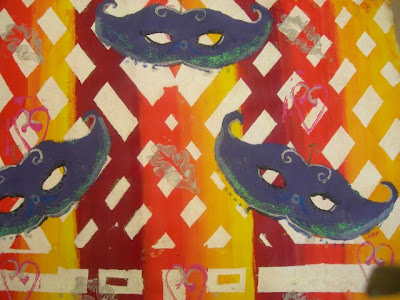
Paint and Print is a project that I have recently taught at a local secondary school. The students who created these canvases are in Year 7 (11 and 12 year olds). I hope you will agree that they did a fantastic job by producing amazing art work designed by themselves.
The aim of the ten week project was to make a large piece of wall mounted art, using different techniques of painting and printing. The brief was for the students to study different styles of masks and their meaning including tribal, Venetian, theatre and horror masks.
The objectives of the project were:
to explore various types of paint and print media
to understand the properties and limitations of the paint and print media
to use color theory to obtain a satisfactory outcome
to make their own printing tools
to consider the elements of good design

So how was it done? First the students were asked to select either cool colors or warm colors and, using diluted acrylic paints, applied these to the surface of the canvas using sponges.
Once dry, masking tape was placed on the painted canvas and a thick coat of acrylic paint was applied with a sponge. The students then had the choice of applying different printed elements to the canvas either with the masking tape intact or removing the masking tape before printing.
The printing applications were as follows:
bubble wrap and/or corrugated cardboard, painted with a thick layer of acrylic paint.
Collograph (string on card) printing blocks, painted with metallic acrylic colors before applying to the canvas.
Printing foam scored with a pencil and printing ink applied with a roller before applying to the canvas.
Commercially bought foam stamps painted with acrylic paint before applying to the canvas.
Once the surface had been decorated and the masking tape removed (tearing off the masking tape is such fun)! the canvas was ready for the masks. Each student made a template of a mask from paper and positioned the template onto the canvas before drawing around it with a soft pencil. The mask was painted in a solid color and, when dry, decorated with Jones Tones foils on a transparent glue base.
The Learning Outcomes. As well as learning about planning and design compostition, color theory and the properties of paint, the students also learned that materials behave differently on different surfaces. One of the "problems" of painting on an absorbent surface, such as on fabric or on a wall, is that a dense surface will absorb color but reflect very little light back (unlike white paper, for instance). For example: purple acrylic paint applied directly from the bottle will look black on a non-reflective surface. To achieve a better purple it is advisable to add a small quantity of white paint. Although the paint looks lilac on the palette it will dry to a darker shade. Another problem of color on canvas is one of contrast. Subtlties in shades and tints are lost on a large surface that is viewed from a distance so it is better to employ color "jumps". What I mean by that is, the subtle changes from yellow to tangerine, to orange, to vermilion, to red will be lost in this type of painting. It is advisable to change colors from yellow- orange - red without the subtlties in between.
A further limitation is that of paint handling and working cleanly, particularly in printmaking. Acrylic paint is notoriously difficult to manipulate when painting complex shapes onto thick absorbent canvas and students learned to mix the paint to the exact consistency to make its application easier. Printmaking is a messy business and students were advised to clean their area and printmaking tools thoroughly, particulary as they used oil based inks and turps to clean them up with.
Each student created a unique piece of art, using techniques that can be applied to other painting and print making assignments. a project such as this can be adapted for any age group, the older the student the more elaborate the finished piece can be.



Wonderful projects. I loved stamping as a student!
ReplyDeleteWhat a great description of your project, I bet you get teacher of the year!
ReplyDeleteVery talented budding artists! Great job.
ReplyDeleteoh, my goodness! what wonderful lessons for the children to learn, and you set up the project to be fun and memorable.
ReplyDeleteevery student should be so fortunate as to have you as a teacher.
What a fun project to be involved in. I hope to start teaching soon myself!
ReplyDelete